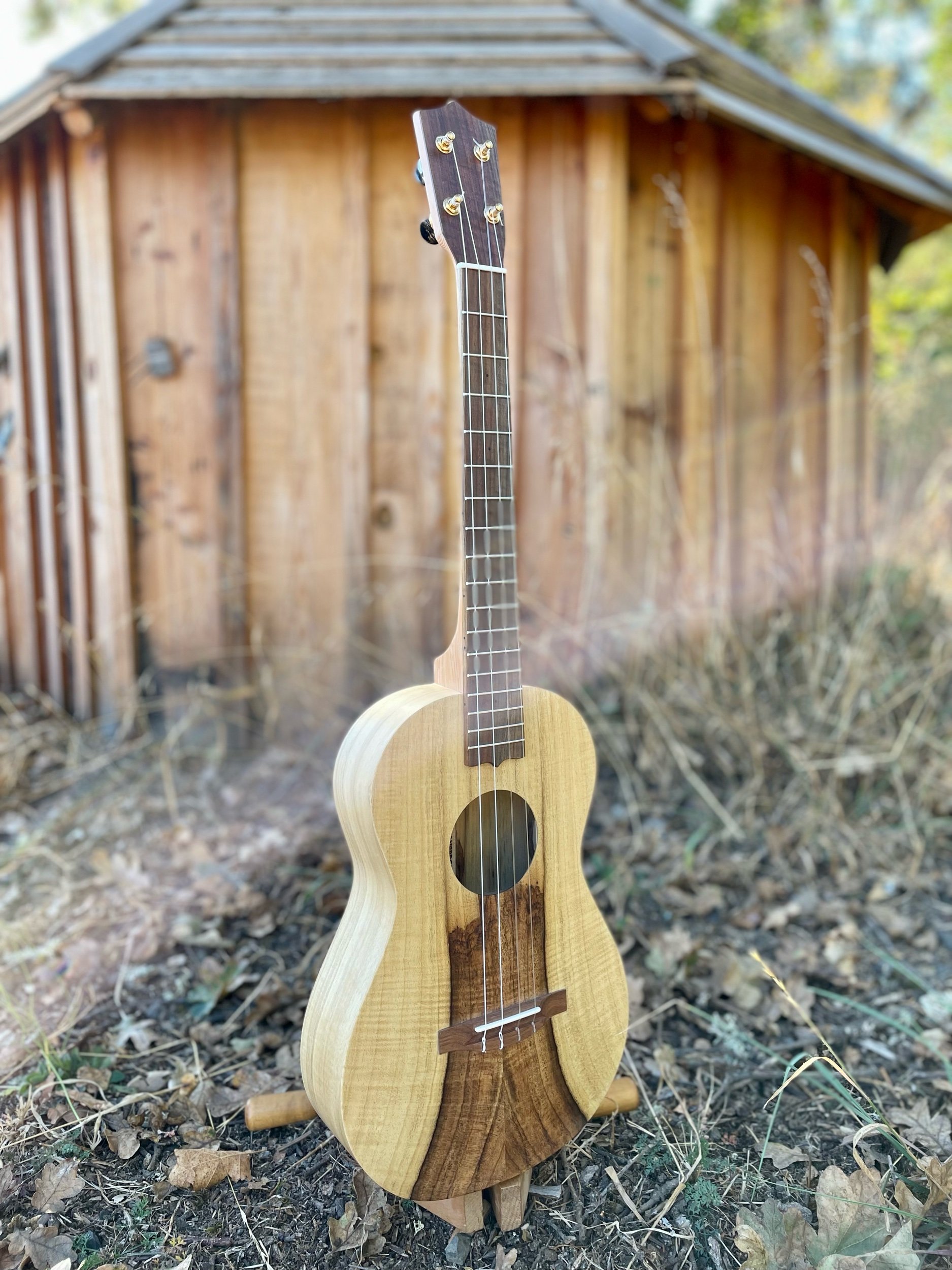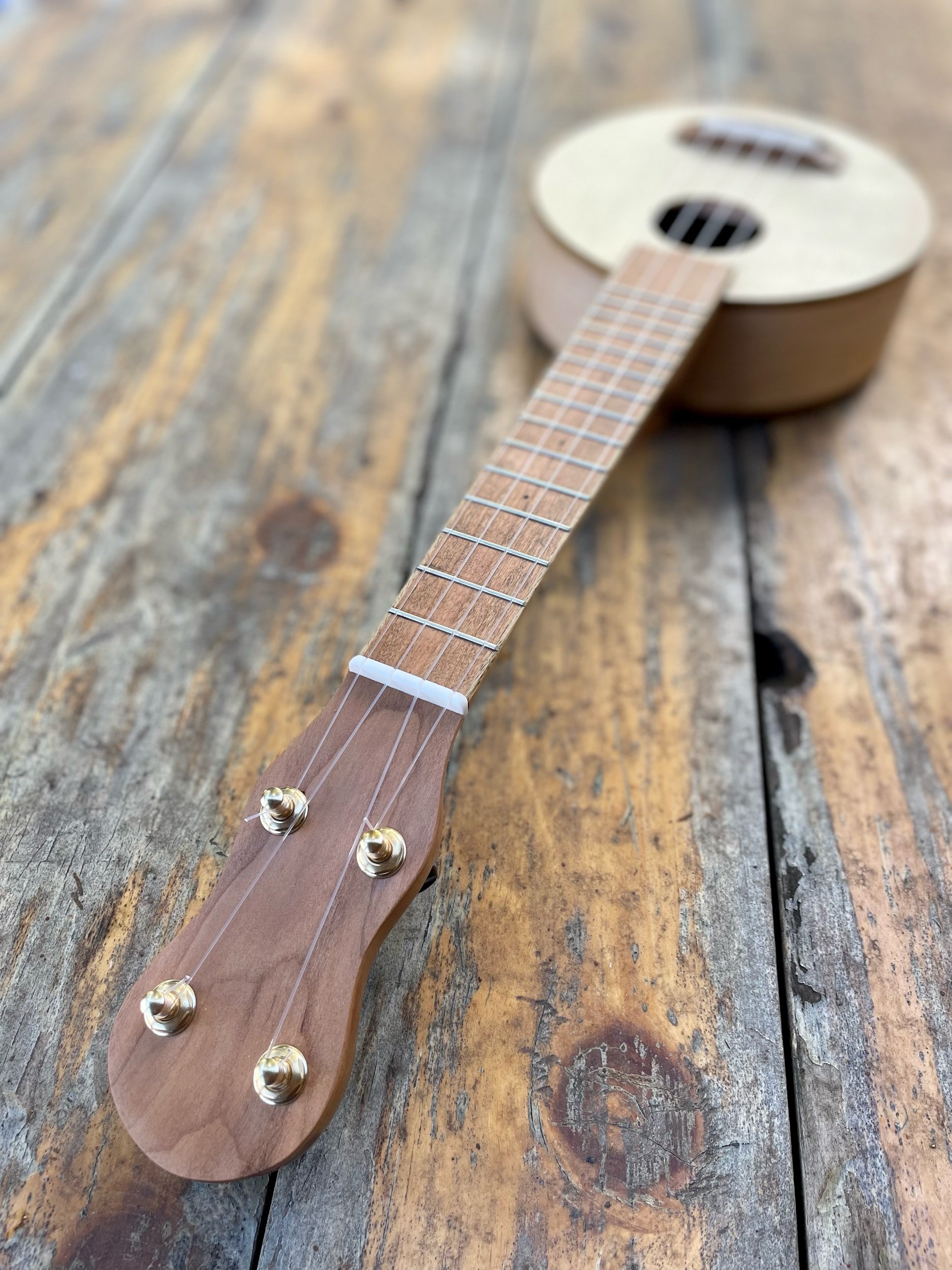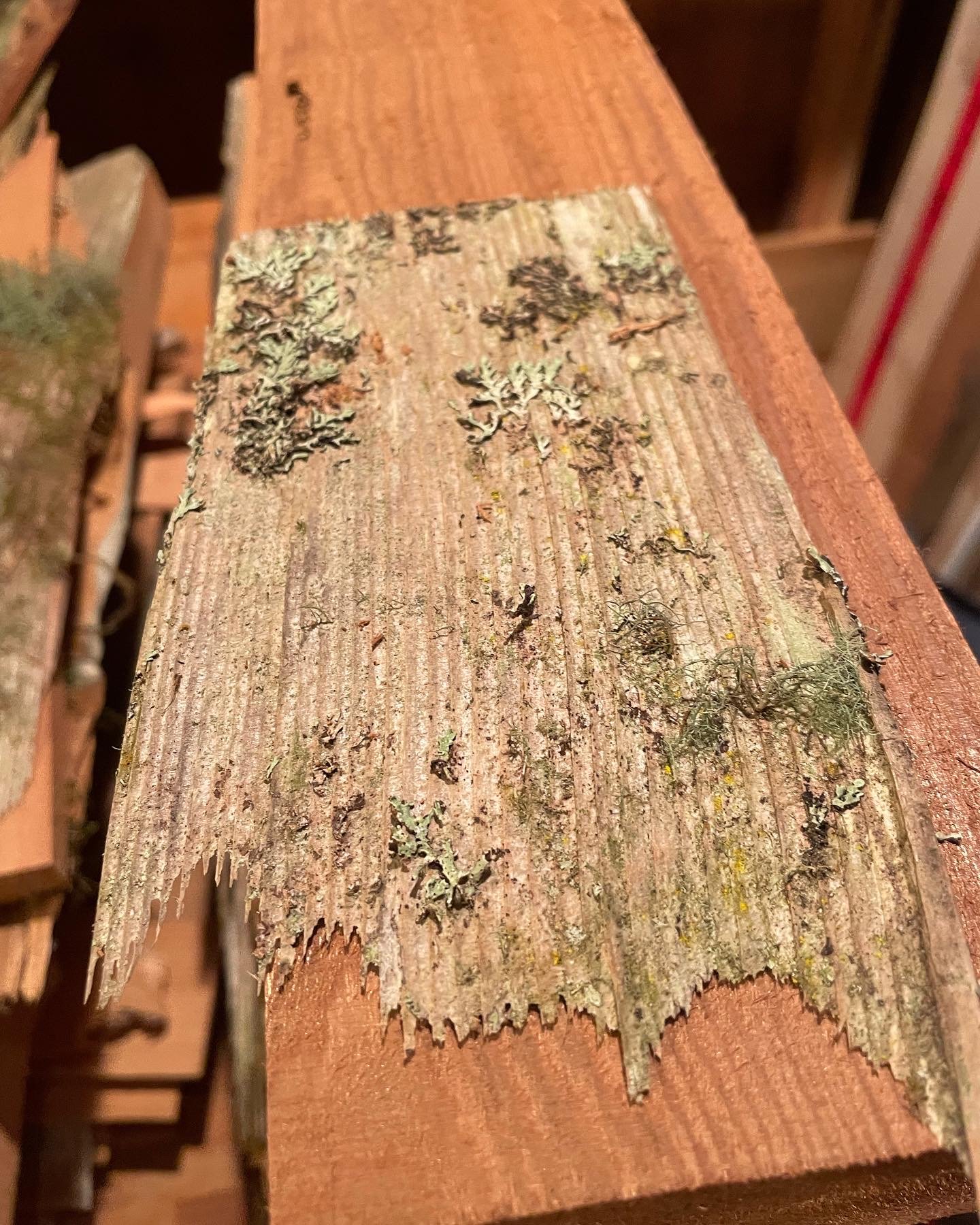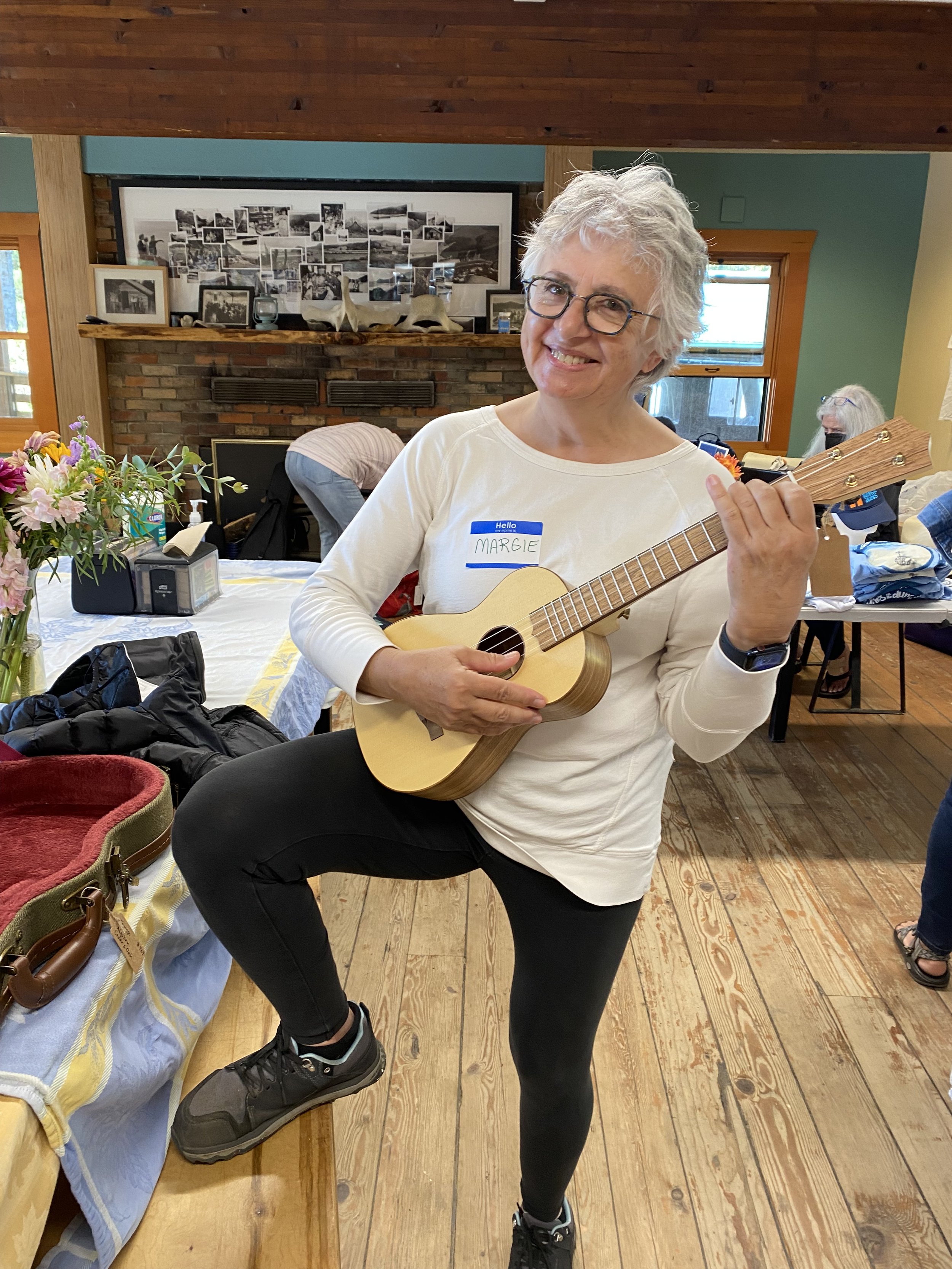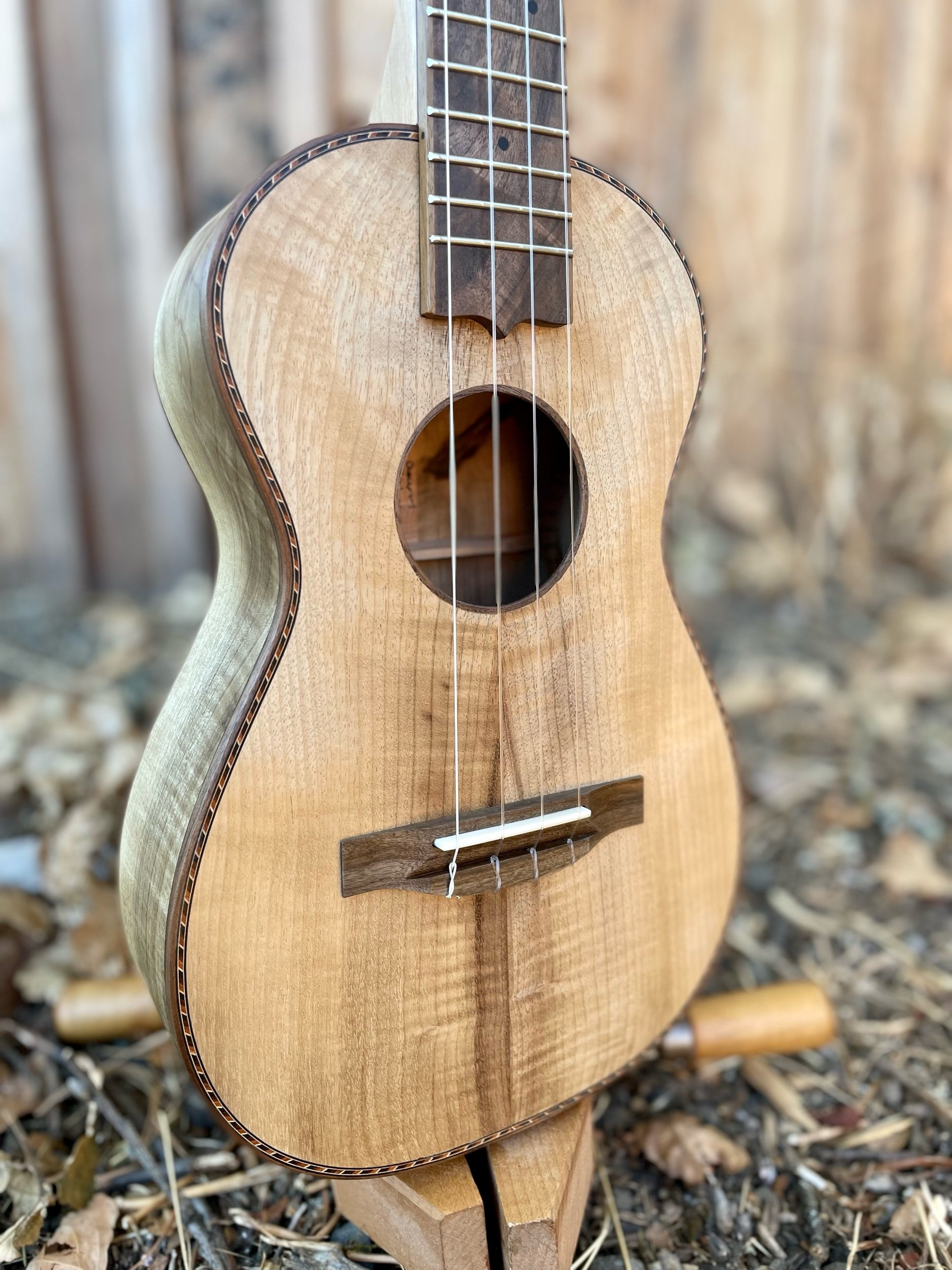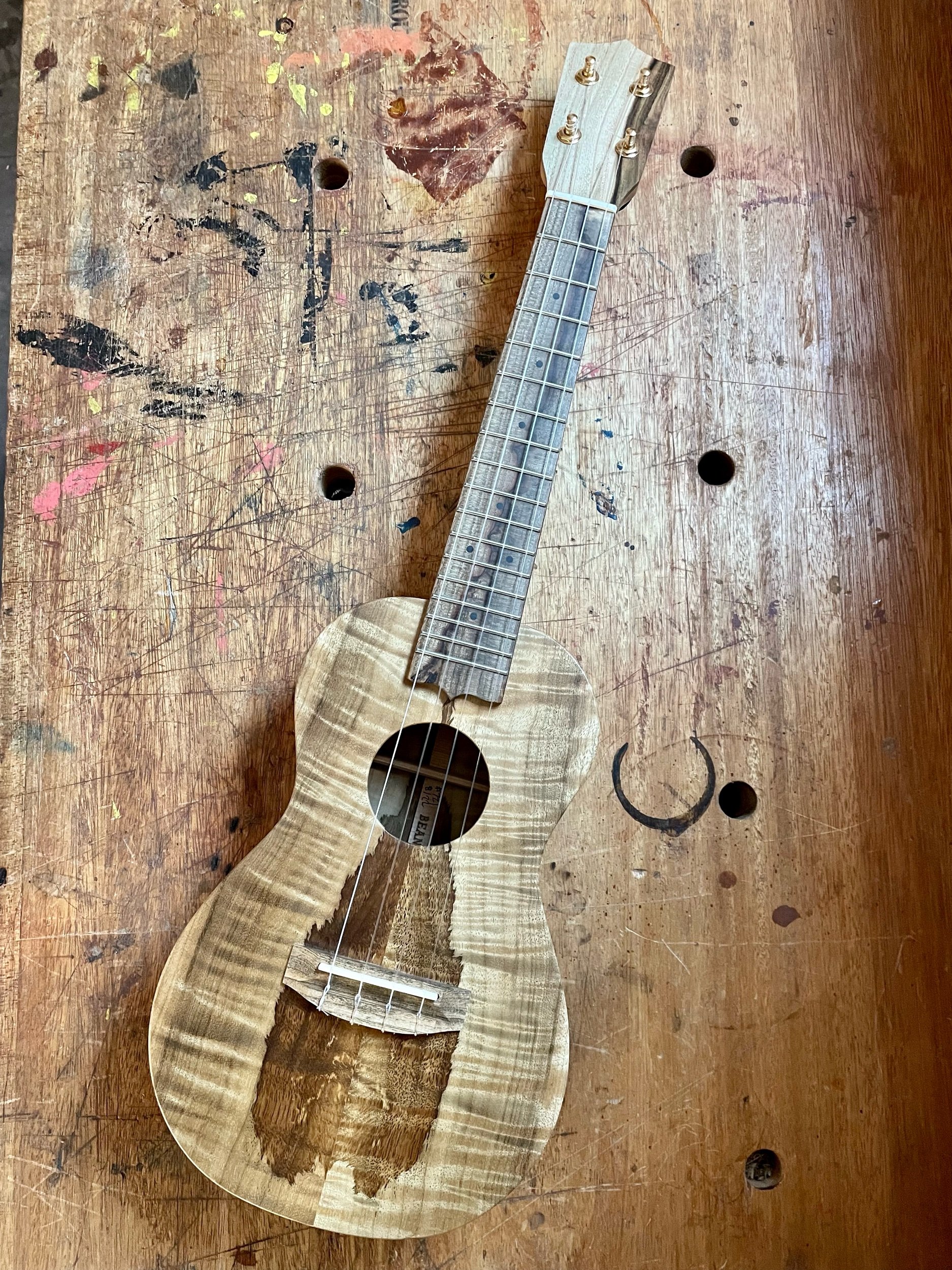I’ve made a habit of selling my personal instruments after playing them for a year or two. After all, I don’t want to upset the sales gods by saying no, and I can always make myself a new one. In this case, I needed a simple baritone ukulele, fast. I chose some beautiful Myrtle I got from Epilogue Lumber. It’s urban salvage and very beautiful. I paired it with some salvaged Douglas Fir and Walnut scraps from a tree here in Hood River.
#738- Spruce and Maple Scout Ukulele
Another scrap bin special here at Beansprout! Maple from my kitchen cabinet project, Spruce from a guitar leftover, Cedar from an old hotub and some Cherry from the Carpenter Ant stash. It’s bright and cheerful, with a nice percussive sound. It’s off to the Scout waiting list asap.
#734-Koa Tenor Ukulele
Koa. It’s a classic. I don’t buy new Koa, but when I stumble upon it or can salvage it, I always do. This Koa is Clockmaker’s Koa from the Carpenter Ant Stash in Portland. It was originally imported by Lizann’s grandfather to make clocks. The Fir neck is salvaged from a floor joist and the Walnut is from a friend’s tree in Hood River. It is light, easy to play, loud and sweet! I’ll be making a donation to plant new Koa trees in Hawaii, so can you right here.
“Greetings from sunny South Carolina! Special thanks to Aaron, Nicole, and Henry for all of the many years of developing and harvesting Beanspout! I feel very fortunate to be part of the Beansprout family now. The Koa uke is, yes, simple; but the warmth, brightness, and melodic voice is simply heavenly. I am so grateful and blessed by you all. All the best! Peace and love,
- K. C. ”
#732- Walnut and Pistachio Five String Banjo
It would be easy to think that this banjo, with a 12” inch walnut rim, no tone ring and non steel strings would be too dark/quiet/warm. But nope, still sounds like a banjo! It’s just the ultimate in sustain, warmth and richness but still has the brightness and punch to do its banjo jobs. The Walnut is a local tree to me, milled by Chris at The Dee Mill. The grafted Pistachio is from California Orchards.
“Good morning Nicole and Aaron,
Even though you sent pics and videos along the way as you were crafting my new banjo, I was still overwhelmed by just how truly gorgeous it is in person. I’ve played guitar for years, but I’m pretty new to the banjo... fortunately, this Beansprout is very forgiving and patient with me as I play, and her sound is the perfect warmth and earthiness I was looking for. I couldn’t be happier. I keep her right here next to me in the home office and pick her up often when the “work walls” start closing in on me.
Thank you so much for putting your heart into building and presenting me with this new Beansprout. I promise to uphold my end of the bargain. She will be right here next to me for years, and I’ll do my very best to fill the air with great music.
I’m so happy I found Beansprout. I’m already saving up for a uke! All the best to you and the family, and wishing you all a wonderful upcoming holiday season.
Cheers,
- M. P. ”
#736- Western Red Cedar and Dogwood Tenor Ukulele
This instrument is inspired by a baritone ukulele I made for Lizann, keeper of the Carpenter Ant stash. I like how all the reds, tans and browns flow together with no black purfling, laminations or inlays. The Dogwood back and sides are from a tree on Lizann’s property that her dad Ken milled many years ago. Dogwood is rather hard and serves well as a back and sides for ukuleles. The Cedar top is also from the Carpenter Ant stash, from a board that Ken bought to use for ukuleles. The Pistachio fretboard/head plate/bridge is all green/brown swirls, which is a good match to the Dogwood. The Cedar of Lebanon neck is from the scrap bin at Camp Westwind. I have no idea if it was labeled correctly or how this non-native tree came to be there. Cedar is a nice choice for ukuleles, as it has nice sustain and a rusty brightness as well.
#733- Curly Myrtle Soprano Ukulele
We have always called Myrtle “Oregon Koa” and this one lives up to the title. It looks nice, sounds nice, is local to us and easy to work. In a soprano like this, it sounds like the more traditional Koa, but with a little more sparkle. This Myrtle comes from the Carpenter Ant stash in Portland, the Walnut from Hood River and the Fir is salvaged from a floor joist.
#731- Walnut and Pistachio Five String Banjo
The combination of a Walnut rim, a skin head and non steel strings is always fun. It is dark and rich, but has plenty of growl and punch when I dig in. I like that the customer added some rope binding and a brass arm rest to make it a little fancier. If I were left to my own devices, I would probably make all the banjos a little too plain! The Walnut is from Hood River via The Dee Mill and the Pistachio is from California orchards.
“Aaron and Nicole,
I just wanted to let you know that my 5-string banjo arrived yesterday and was in perfect condition. As with the other Beansprout instruments, I couldn’t be more pleased with how this instrument has turned out.
As I have said before, I appreciate your philosophy of primarily using local and salvaged wood in your instruments. The care and thought you give to each of your instruments shows in all the details and high quality of your craftsmanship.
Most importantly I am very pleased by the sound of this instrument. I was looking for an “organic” and darker sound spectrum in my banjo as compared to the bluegrass banjo that I have been using. It is a much better sounding instrument for accompanying my voice and playing solo and in small groups.
I feel very fortunate and honored to have Beansprout instruments and look forward to continuing to make music with them. Thank you also, Nicole, for your part and artistry in supporting the Beansprout experience.
Aaron, Nicole, and Henry....take care, stay safe and stay well.
- D. B. ”
#735- Western Red Cedar and Curly Walnut Alto Ukulele
Man, this one is pretty! I really love the sapwood in the Cedar top, the wavy Pistachio head plate and the bird’s foot purfling. This combo is always sweet sounding, with a rich sustain but chiming sparkle too. The Cedar is from luthier Jayson Bowerman near Bend, OR. The Walnut is from Goby in Portland. The Pistachio is from California orchards and the Cypress neck is salvaged from an old tank.
#729- Western Red Cedar and Walnut Alto Ukulele
This ukulele is for our friend Melany, who has run the Tunes in the Dunes event at Camp Westwind for the last 10 years. I wanted to make an instrument rooted in the beautiful place she lives, right on the Salmon River, across from Westwind.
The top, headate, endgraft and healcap are all Western Red Cedar from a fence post salvaged from her property. The top was planed and sanded while the rest retains the rough texture, moss and lichen from the post. The walnut back, sides and fretboard are from Hood River, from a standing dead tree likely planted over 100 years ago. I love all the swirling colors of it. I used Alder for the neck, as it is another Oregon wood vital to the forests and waterways. The binding is greenish Myrtle from the coast, tying it all together in a muted way. For the strap buttons, I used rusty fence staples from her post, I love their rough texture compared to the smooth wood.
If you peek in the sound hole, you will see a little collection of moss, shells and sand from Westwind. To help protect the vital Salmon River watersheds, go here to learn more and donate.
#737- Alaskan Yellow Cedar and White Oak Tenor Ukulele
This AYC top came from neighbor’s shop, left over from when he made flutes. It inspired me to make an all domestic wood instrument with the muted color palette I like. The White Oak is from the Carpenter Ant stash and the AYC neck is from Camp Westwind. A mix of Myrtle and Walnut was used for binding and bridge, which complements the amber tones but fits in the palette. And the sound! I always love Oak for back and sides, but this piece of AYC warms it up a bit.
#726- Curly Port Orford Cedar and Mahogany Alto Ukulele
This beautiful stock instrument went to music camp with me and did not come home. It is made entirely of salvaged wood. The Port Orford Cedar top comes from cleaning out my flute making neighbors shop, the Jatoba fretboard/head plate/bridge comes from the Carpenter Ant Stash, the African Mahogany comes from an estate sale in Colorado and the Spanish cedar neck is from a retired banjo builder.
#722- Curly Myrtle Tenor Ukulele
This is a stock tenor I made to take to two music camps this month. If it makes it through those without finiding a home, it will be available on our website. Myrtle tenor ukes have been our bread and butter all the way back to the Mya-Moe days. Bright but rich, beautiful and local, Myrtle is always a classic choice. This Myrtle is from the Carpenter Ant stash, the Walnut is from a Hood River walnut tree and the the Fir is salvaged from a floor joist.
#727- Western Red Cedar and Curly Walnut Baritone Ukulele
This instrument is our second for musician/actress Zooey Deschanel. She wanted a baritone uke that looked fancy and had a deep rich sound. No problem. I drew some inspiration from the singing cowboys of Hollywood’s golden age for the inlay and rope binding. Looks fancy to me! The top is salvaged Western Red Cedar from wall boards. The Claro Walnut back and sides and the Spanish Cedar neck are from retired luthiers. The Pistachio is from California Orchards.
#723- Spruce and Maple Scout Ukulele
Built for the auction at Tunes in the Dunes in September, to benefit Camp Westwind. Spruce and Maple from Westwind, Fir and Cherry scraps from the Carpenter Ant Stash in Portland and shop made rope binding.
#725- Maple and Jatoba Short Scale Five String Banjo
I’m not sure what to call this “model,” but it’s proved popular. It’s a basic five string banjo based off my personal instrument, built from whatever woods are on hand and then stained to match. I usually use a maple rim, in this case also a maple neck and Jatoba (Brazilian Cherry) everything else. The head is stained with walnut shells from our yard, the hardware is darkened and it has a K&K pickup, ready for the stage. It has a bright tone, but a lot of depth and richness as well, its on its way to Norway!
#728- Myrtle and Oak Scout Banjo Ukulele
I have been thinking about making some banjos with the same philosophy as my Scout ukuleles: lighter weight, humble designs, cheerful tone and made from whatever scraps are floating through the shop. The main thing that has been holding me back is producing thin, lightweight, laminated rims. These are made much differently than my normal block rims, they are steamed, bent and glued together from two oak layers. I was going for an old timey, chipper tone and it worked. I also learned a lot about steam bending rims and look forward to producing more.
I paired this rim with a Myrtle neck, oak fretboard and some walnut trim. It has less brass hardware than normal, a flat fretboard, a skin head, geared tuners, fluorocarbon strings and comes in a gig bag.
“Hallo again, Keims. :-)
Pictures and your video were great, but still didn’t quite capture the overall golden hue of this one, and how well the oak and myrtle go together (as is typical, more muted/blended in person than in images which tend to highlight grain and contrast that the eye doesn’t typically see.)
Plus, your finish combo + these woods = smells like brewed black tea. :-)
And, what a perfect instrument *for me*. Meaning, my instincts from afar are more than confirmed now that I have this in hand, strumming and plinking and plucking, which is a great feeling in and of itself.
The size, weight, balance and minimal appointments (with those great brass fittings still an abundance, relative to any other instrument I own!) suit me so very well, and boy howdy what great tone. I don’t know if I can get away with calling it (or any banjo!) mellifluous— hah — but it’s just so... smooth— plenty of twing and the twang and some spank when wanted, but without the harshness(?) I’ve encountered in others.
I’m going to have a *lot* of fun with this one. :-)
It’s different and it’s great and I love that you made it, and that it’s mine.
Thanks again!
- S. S.
”
#724- Cherry and Texas Ebony Five String Banjo
Cherry is a great banjo wood. It’s loud but not too bright, has a sweet voice to the high end and a little growl on the bottom end. It is readily available, easy to work and darkens over time to a rich glow. In this case it is paired with some Texas Ebony I got from a retired banjo builder, including some nice sap wood pieces for contrast. Non steel strings, hawktail tailpiece, wire armrest and a skin head make it unique. I’m really pleased with it, especially the headstock inspired by an 1880’s Hawaiian Rajao.
#719- Spruce and Myrtle Alto Ukulele
Some wood sets show off how crazy wood grain can be, but this one just seems calm to me. Visual calm can be a good thing, especially for an active mind like mine. I love the tone of this spruce top, it sounds precise all the way up the neck. The Spruce is from luthier Craig Wilson, cut many years ago on Vancouver Island. The Myrtle is from the same board as Nicole’s ukulele, from a roadside stand near Manzanita. The neck and fretboard are made from salvaged Fir from a floor joist and local Oregon walnut.
#721- Mastergrade Myrtle Alto Ukulele
This Myrtle set offered up a bit of a paradox to me. It used to be a living tree, but now it is dead, but it looks like it’s still growing! I chose the Pistachio fretboard/head plate to continue this idea and it turned out great. The Pistachio and Myrtle are from woodfromthewest.com, the Fir neck is salvaged from an old beam.
“Hi Aaron and Nicole, I’m in love!!! My uke is so special. Can’t wait to show it to my buddies. Everything about it is exactly what I wanted. Sure glad no one wanted the myrtle; it was waiting for me. Unless it’s my imagination, the wood has a sweet smell to it. THANK YOU!
-K. T. ”

